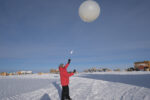The spring IceCube Collaboration meeting wrapped up last week in Aachen, Germany, which was hosted by RWTH Aachen University. Over 200 members of the IceCube community attended the meeting either in person or virtually. For the second straight year since the pandemic began, the biannual collaboration meeting was held in person, with virtual offerings for […]
News
2023 IceCube Impact Awards announced
The results of the tenth edition of the IceCube Impact Awards were announced this week at IceCube’s spring collaboration meeting in Aachen, Germany. During the ceremony, IceCube spokesperson Ignacio Taboada gave each recipient a certificate and mug to commemorate their achievements while those who could not attend joined virtually. The awardees are Cristina Lagunas Gualda […]
Week 10 at the Pole
IceCube winterover Marc stationed himself nicely to get this photo of the sun setting behind the ceremonial South Pole. He photographed it from a distance last month, under clear skies when the sun was still high. But you don’t need a month for the environment to look different. The two photos below of the IceCube […]
IceCube’s first study on seasonal variations of atmospheric neutrinos
Atmospheric muons and neutrinos are the most abundant signals detected in IceCube. They are produced in cosmic-ray-induced air showers in the Earth’s atmosphere. Cosmic rays are high-energy protons and heavier nuclei traveling through space. When these cosmic rays reach Earth and collide with atoms in the atmosphere, they create an avalanche-like cascade of secondary particles […]
Help IceCube decode signals from outer space
Every second, about 100 trillion neutrinos pass through your body unnoticed. At the South Pole, the IceCube Neutrino Observatory detects these elusive particles and works to identify their astronomical origins to help unlock mysteries of the universe. Such an undertaking requires a massive amount of data, with one terabyte of data recorded daily by IceCube. […]
Week 9 at the Pole
Although it was generally quiet last week, IceCube’s winterovers took some interesting photos of their activities and surroundings. First up, weather balloon launching. Winterover Marc put his training to work as he was on weather balloon duty last week. On one of those days, a sundog appeared just at the right time to serve as […]
Week 8 at the Pole
The sun has not quite set at the South Pole, but it’s low and the shadows are getting longer. Last week, IceCube’s winterovers were busy (working and playing) outdoors. Marc learned to launch a weather balloon, so he can join the rotation of volunteers to launch daily balloons as there’s no meteorologist stationed at the […]
Week 7 at the Pole
Winter officially began last week at the Pole with the final flight departure (above) and the last traverse, SPOT3 (below), leaving the station. The plane carried away the few remaining summer personnel, who did not want to miss that flight since the next one out wouldn’t be for another eight months or so. So, who’s […]
Week 6 at the Pole
As the sun continues its slow descent, the temperatures at the Pole have been dropping as well—last week they reached –40 °C (which also happens to be –40 °F), cold by anyone’s standards. Everyone at the South Pole station has been preparing for the upcoming station closing. The last shipment of fresh vegetables that they’ll […]
Week 5 at the Pole
This aerial view of the IceCube Lab (ICL) suggests that last week’s kite-camera tests proved fruitful. The low sun and the long shadows indicate that summer is on its way out, although that’s a long, slow process at the South Pole. Meanwhile, IceCube’s winterovers have been keeping busy. Last week, they gave a few tours […]









